The Ultimate New Zealand Soccer Website | home
Notable Vessels - 1800s To 1950s | History 1907 - 1955 | 1960s Herald Story | Demise Foreseen | Onehunga Wharf's Changing Face | View From The Mountain | Papers Past | Servants of the Port | A Wharf of Contrasts | Signal Station Signs | From the AHB Archives via NZMM | Steam Arrives On The Manukau | High And Dry?
Notable Vessels - 1800s To 1950s
Following are a few vessels whose names cropped up during the course of researching the Port's history.
The background photo is the New Zealand Civil Ensign, the red New Zealand flag you'll see on all locally flagged vessels.
Airedale
|
The Intercolonial Royal Mail Steam Packet Co. operated her on the west coast, serving Taranaki, Wellington, Nelson, Hokitika and Bluff from the Manukau during the 1860s, often under the command of Captain Archibald Kennedy, the first man to receive a Pilotage Exemption Certificate in NZ.
Originally built to carry locomotives in the Mediterannean, she was introduced to the interprovincial service in 1859, first visiting the Manukau on 12 September.
On 26 March 1860, she picked up 88 men of the 65th Regiment, landing them at Waitara, whereupon she took on board 92 refugees - including 33 women and 55 children - and landed them at Nelson.
She struck a reef near Taniwha Point on 14 February 1871, en route from Onehunga to New Plymouth. Her twenty passengers and ten crew were able to get to shore in the ship's lifeboats, while her cargo of mail from England was retrieved later, as were the ship's engines - the hull was abandoned.
|
Albatross
|
A 66 foot, two-masted ketch built in 1904 which operated a regular timetabled service between Onehunga and Port Waikato from 1912 until coming to grief on a run from Onehunga to Marokopa four years later, when she ran aground on the bar and was pounded to pieces by the prevailing heavy seas.
|
Arrah Na Pogue
|
A three-masted scow whose Irish Gaelic name translates to "a secret kiss". Built by G. Niccol in Auckland in 1912, she was 186.52 tons, and 116 feet long. Under the command of Captain R.C. Somerville, she paid an annual visit to Onehunga in the years after the Auckland Harbour Board took over the running of the port before being sold to Australian interests in 1916, whereupon she was renamed "Cathkit". After being laid up in Sydney's Blackwattle Bay in the early 1920s, she was converted to a motorised ship for trading between the Tasmanian ports of Ida Bay and Electrona, carrying limestone right up until September 1975.
|
Avon
|
Operated during the Waikato campaign, carrying troops and stores from Onehunga. Roughly the size of a seaward defence motor launch, she weighed 40 ton, drew three feet of water, was armed with a low-mounted twelve pound gun, and was protected by quarter-inch iron plates bolted onto the wheelhouse courtesy local engineer George Ellis.
Built in prefabricated form in Glasgow in 1859 by Barclay Curle, she was both the first steamer to enter the Waikato River and the first battleship on the Manukau. With a party of naval ratings and coastguards on board, she was commissioned to seize some canoes belonging to hostile natives.
|
Awhitu
|
Operated in the mid-1880s for the NZ Iron and Steel Company, bringing ironsand to the works for processing.
|
Awhitu
|
Built by R. Lang of Auckland and purchased in 1949 by Bill Hudson of Graham's Beach, she was the last vessel to run a passenger service on the Manukau Harbour. A 45 foot launch licensed to carry 90 passengers, she regularly called at Huia, Cornwallis and Whatipu, amongst other locations, for eight years, before being sold in 1957.
|
Bellinger
|
Chartered by the Jubilee Steam Ship Company on behalf of the NZ Seamen's Union to run a competing service against the Northern Steam Ship Company on the Onehunga - Taranaki run in 1887-8, as a form of protest against the terms on which Northern employed their ships' crew. She was chartered for four months, and in that time incurred costs of 878 pounds charter fees, 712 pounds in wages, 240 pounds for provisions and 82 pounds 10 shillings for coal. She was replaced on the run by SS "Planet".
|
Berhampore
|
Brought a contingent of Fencibles, to later reside in Onehunga, in June 1849, under Captain John Jermyn Symonds and Chief Officer William Davies.
|
Blue Nose
|
A 50 ton wooden sidewheel paddle steamer built by John Bigelow - the first steamer built on the Manukau, she was launched from the beach in 1 April 1864 for the McLeods, Helensville-based timber merchants. She measured 85 x 15 feet, while her wheels propelled her at 6.5 knots, sourced from a 53hp engine.
She regularly ran from Onehunga to Hamilton, supplying timber for military and civilian use until 1870. Believed to have been the first vessel to carry cargo to Port Waikato, she landed the first boatload of female settlers at what we now know as Hamilton in 1865. She served the Waiuku Steam Navigation & Coal Mining Co Ltd of Ngaruawahia until being broken up in 1881.
|
Brilliant
|
Anchored off the entrance of the Manukau at the end of October 1841, after a ten-month voyage from Scotland. Captain Ritchie took her into the harbour using a rough sketch plan provided by Captain Thomas Wing.
28 November 1841 saw the first settlers for Cornwallis arrive on this vessel, once again under Captain Symonds. 27 Scottish immigrants disembarked, brought out under the auspices of the Manukau Company.
|
Charles Edward
|
A paddle steamer of 147 tons built by Archibald Denny of Dumbarton for the Otago Steam Ship Company, she was swiftly sold to Australian interests before being acquired by Nathaniel Edwards & Co. of Nelson in 1868. That company traded as Anchor Shipping, and "Charles Edwards" became the first of their vessels to visit Onehunga on 3 September that year, arriving with 97 gold-diggers bound for Thames. She continued to serve Anchor until stranding on the Wanganui River bar on 15 December 1908, becoming a total loss.
|
Cordelia
|
A 579 gross tons sloop built in Pembroke in 1856, she carried 185 troops from the Manukau to Taranaki for the Land Wars in that region in June 1860, making the same trip a month later with 123 troops aboard for the defence of New Plymouth and its environs.
|
Corio
|
An overseas steamer which briefly traded between Nelson, New Plymouth and the Manukau on the cattle trade, first crossing the Bar on 18 April 1861. The following month - 16 May - she departed from the Manukau for Sydney, trade having failed to measure up to expectations.
|
Daring
|
A coastal trader built at Mangawhai in 1863 as a two-masted schooner, she was driven ashore by gales - with no loss of life - two years later near the entrance to Kaipara Harbour, following an error of judgement by her Master on the return leg of a voyage from Taranaki to Onehunga, carrying a cargo of grass seed.
Amazingly, in September 2018, her remains were revealed by Mother Nature, and a major operation was undertaken by a group calling themselves Daring Rescue - click the link to go to their Facebook page which documents the ship's history and recovery process.
|
Ellen
|
A cutter of 15.40 tons, she was launched at Waiuku in 1860.
|
Elsie
|
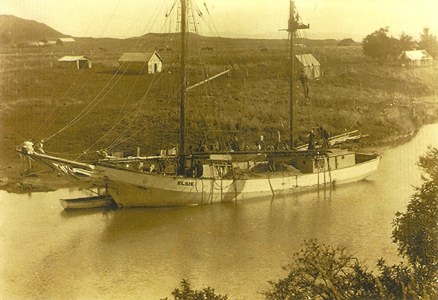 A ketch-rigged vessel launched on 22 March 1904 at Bailey & Lowe in Auckland, she collected a cargo of coal at Whangarei on her delivery voyage, landing it at Waiuku. She boasted 33hp engines as well as sail power, and was built to carry cattle and heavier freight around the Manukau, in tandem with "Weka".
|
Erskine
|
Built in 1875 by Rait & Lindsay in Glasgow, this 138 feet long bucket dredge had 36 buckets and was capable of dredging between 250 and 300 tons per hour from a depth of 30 feet. Owned by the Westport Harbour Board, she was employed to dredge Onehunga and the Manukau in the early 1900s - the first instance of dredging at the Port.
|
Falcon
|
A 10 ton steam launch built in 1895 by D. Greenwood at Onehunga for T.H. Barwell, who employed his pride and joy on various jobs on the Manukau over the next twelve months, principally as a tender to the fishing fleet.
|
Favourite
|
A cutter built at Onehunga in 1862, she was 17.75 tons and 42 feet in length. Owned by Onehunga mariner T. Williamson, she sailed from the Manukau in April 1866 and disappeared.
|
Gairloch
|
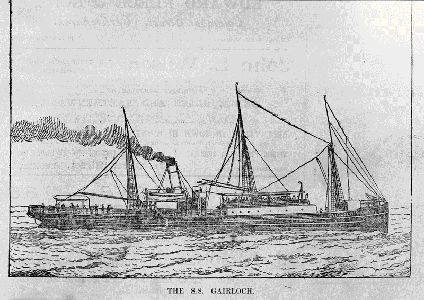 JT Diamond collection, Auckland Lubraries, JTD-19M-03520
Built in Glasgow in 1884 for the Northern Steam Ship Company, who put her on the Onehunga - New Plymouth run, initially carrying cattle. While on passage northbound on 19 May 1887, she broke her port propeller shaft, and eventually had to be towed into Onehunga.
Of 373 gross tons, she was the last ship in the Northern Company to be given a Scottish name, and was also the first vessel from the Company's fleet to be wrecked on the coast. (See also Harbour Incidents).
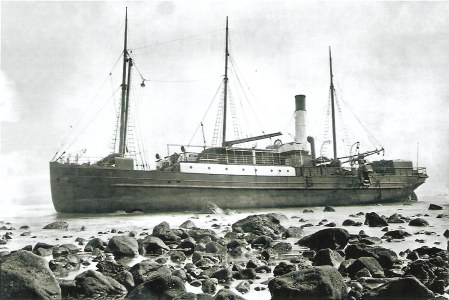 She met her end when on passage from Onehunga to Wanganui, running aground in thick fog on Oakura Reef (above) at 11.40pm on 5 January 1903. Rocks penetrated the hull, and while all hands were able were able to get to shore, there was no saving the ship, and her bow could still be seen intact and lying in a hollow of the reef thirty years later.
|
Halcyon
|
The first steamer built specifically for the trade on the Manukau, between Onehunga and Waiuku and all stations in between. She was built of heart kauri milled from the adjacent forest by Wing Brothers at Paratutai, and launched on 27 March 1866 before sailing to Onehunga for fitting out. She could carry 35 tons of cargo, and was driven by twin screws, each individually powered, giving her a shallower draft and greater manoeuvrability. She made her maiden voyage on September 13, 1866, but only visited Waiuku three times in the next three months, prompting her owners to take her off the run three months later and sell her to interests on the South Island's west coast.
|
Hawea & Taupo
|
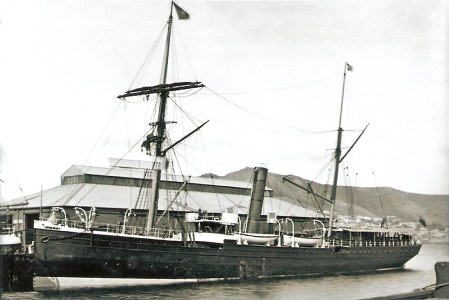 With "Taupo", a real 'pioneer' of North Island coastal trade, from July 1875 she carried out a twelve-day round trip between Onehunga, New Plymouth, Nelson, Picton, Wellington, Lyttelton and Dunedin, carrying mail, cargo and passengers, regularly keeping to schedule despite her lack of horsepower (800hp).
Both ships were built by William Denny and Brothers in Dumbarton, and were operated by the Union Steam Ship Company. They boasted a crew of 22, and were of 721 gross tons apiece.
"Hawea" continued the aforementioned route until 12 June 1888, when she was wrecked in New Plymouth Harbour, apparently on an uncharted rock on arrival from Onehunga
|
Jupiter
|
A ketch of 26.56 tons, she was launched at Onehunga in 1860 by Elias Lacy Harrison.
|
Kaitoa
|
Succeeded "Kennedy" and "Murray" on the Nelson run, continuing the service through to the First World War.
|
Kaniere
|
Built in Dumbarton in 1886 for Union Company, she was acquired by the Northern Steam Ship Company in 1893, and caught fire at Onehunga three years later, with 300 pounds' worth of damage being done. She was repaired and continued to serve the company for another twenty-six years.
|
Kate
|
A 23.75 ton cutter, she was launched on the Manukau in 1861.
|
Kennedy
|
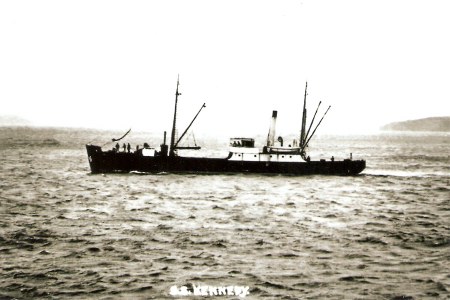 On October 20, 1875, this twin-screw steamer began a service linking Onehunga with Nelson, Waitara, Wanganui, Westport, Hokitika and Greymouth carrying coal, cargo and passengers. It was the start of the Anchor Shipping Company's 107-year-long service between Nelson and Onehunga.
|
Kia Ora
|
A 300 ton steamer built by R. Duncan at Port Glasgow in 1896, she measured 120 x 23 x 12 feet, and first worked for W.A. McGregor on the Auckland - Coromandel run, before being sold to the Union Steamship Company in 1898. While sporting the red-and-black funnel, she carried out a variety of tasks, among them laying cable in Bass Strait for a telegraph company to whom she was under charter in 1900, then a spell in Fiji a year later.
In 1903 she was acquired by the Northern Steam Ship Company, and was unleashed on a run between Onehunga and New Plymouth, calling at all ports in between under the command of Captain J.C. Blacklock. At 3am on 13 June 1907, she was northbound from Waitara to Kawhia when a big swell landed her on Piritoki Reef off Tirau Point. She slipped off the reef and sank, with the loss of two passengers and Captain Blacklock. Ten passengers and eighteen crew survived, and were rescued by "Rarawa" and "Muritai".
|
Lady Barkly
|
Built as a paddle steamer in 1861 by George White at Williamstown, Victoria, she was powered by a 25hp engine, weighed 43 ton, and measured 91.9 feet by 12 feet, with a six foot draught.
She was purchased by the NZ Government in 1863 as an unarmed troop carrier for duty during the Waikato campaign under the command of Captain Fairchild. She was primarily used to seek and destroy Maori canoes which might be used to transport an invading force, and for ferrying men and supplies between the Manukau and the Waikato Heads.
Her maiden voyage, to Drury, took place on 26 October 1863, but she ran aground on the return trip to Onehunga and was stranded for a fortnight before being freed. Soon after, she was used to capture a number of natives camped between the Manukau Heads and Waiuku, returning to Onehunga with her captives. Captain Parnell then led a detachment of Naval Volunteers to Awhitu on "Lady Barkly" to capture more natives.
A gun was added to her armament, allowing her to shell all fortified positions on the Waikato riverbanks. Following the conclusion of the Waikato campaign, she was laid up on the Manukau mudflats until she was acquired by the Red Cross Line in 1867 for employment on a service linking Nelson, Waitapu and Collingwood, a run she maintained for the rest of her career until she was broken up on Haulashore Island, Nelson, in 1934.
|
Ladybird
|
A 421 gross ton sailing schooner built in Dumbarton in 1851 which operated for the NZ Steam Shipping Co Ltd between 1871 and 1875 linking Onehunga with Taranaki, Nelson, Picton, Wellington, Lyttelton and Dunedin, transhipping passengers and cargo at Wellington for Napier, Poverty Bay and Wanganui, and at Nelson for Westport, Greymouth and Hokitika.
|
Lord Ashley and
Lord Worsley
|
Built in Hull in 1857, they served the coastal trade for the Intercolonial Royal Mail Steam Packet Company, with one operating the Nelson - New Plymouth - Manukau run, then swapping with the other to carry out the Nelson - Wellington - Lyttelton - Port Chalmers run, after arriving in Nelson from Sydney carrying passengers and mail.
Lord Ashley encountered problems on a New Plymouth to Manukau voyage in December 1859 when she started leaking badly after leaving port. The ingress got to within three inches of the fires which powered the steamer, but by pumping and bailing the level was reduced and she was able to reach the Manukau safely. Temporary repairs were carried out, after which she returned to Sydney for overhauling on the Pyrmont slipway.
Typical fares of the time between Wellington and the Manukau were 10 pounds for a cabin and 7 pounds for steerage
|
Maid Of The Mill
|
A 27.5 ton schooner, she was owned by Robert White and built by Robert Wadeson White, under the supervision of Captain Theophilus Heale. She was built a quarter of a mile from the water at Onehunga, and was launched on rollers supported by a cradle on 18 October 1842 - the first vessel of significant size to be launched on the Manukau. Fittingly, on the news that gold had been discovered in Otago, she was the first vessel to leave Onehunga under Captain John Grundy, laden with provisions and equipment bound for the goldfields.
|
Manukau
|
The pride of the Harbour from 1880 to 1894, she was built by William Holmes and operated between Waiuku and Onehunga for the Waiuku and Onehunga Steam Navigation Company, carrying livestock, goods and passengers between the settlements.
Launched on 10 August 1880, she achieved ten knots on her sea trials, and commenced service on 15 September, carrying 300 ewes and lambs to Graham's Beach, before carrying her first passengers two days later. On 1 June 1882, she suffered a mishap, losing her propeller and shaft off the Heads, and only making it back to Onehunga under jury sail.
She was re-engined in 1885, and sold nine years later to Waitara interests. She was wrecked on the South Spit at Waitara on 12 March 1912.
|
Maori Chief
|
Built as an iron stern wheel steamer in Leith, and reassembled in Onehunga in 1865 by George Hodge for Ralph Simpson, she measured 78 x 11 feet and was powered by a 25hp engine before being converted to a 35hp sidewheel paddle steamer in 1868. She was broken up in 1884.
|
Maori Chief II
|
The first commercial iron steamer to navigate the Waikato arm of the Harbour, she was built in 1881 by George Hodge.
|
Murray
|
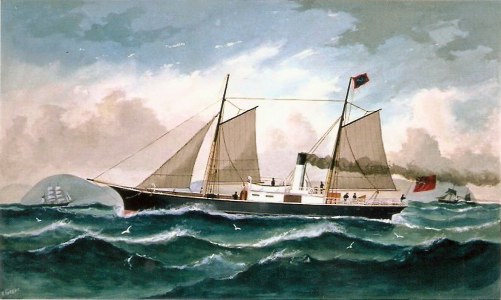 Partnered the aforementioned "Kennedy" on the Nelson run.
|
Nelson
|
The pioneering interprovincial steamer. Built by J. Reid and Co. in Glasgow in 1853, she ran a service from Onehunga to Dunedin via New Plymouth, Nelson, Wellington and Lyttelton which commenced following her arrival on the Manukau on 23 May 1854, under Captain Edward Martin - the first steamer on the harbour. She was withdrawn from the service in mid-1855.
The first call here was of great interest, as it was timed to coincide with the opening of New Zealand's first Parliament - Auckland was New Zealand's capital city in the country's early days. She departed Nelson on May 4 abd called at Lyttelton and Wellington to take on board the local MPs before returning to Nelson prior to departing for the Manukau on 17 May. She grounded soon after, but eventually made passage to New Plymouth arriving four days later.
With more MPs on board, she departed at midnight on 22 May, bound for the Manukau, off which she arrived that afternoon. A signal for a pilot was hoisted, and several gunshots were fired, but no one appeared. With darkness falling, Captain Martin opted to hove to outside the bar overnight, then, using Captain Drury's chart from the "HMS Pandora" survey of 1853, he successfully crossed the Bar next morning and took the ship in himself, steaming up the Wairopa Channel to drop anchor off Onehunga at noon. "Nelson" sailed for her home port on May 26, arriving four days later.
Other calls made by "Nelson" at Manukau were on 11-14 August, 12-18 September, 6-8 November, 23-27 December, 22-26 January 1855, 27 February - 2 March, and finally 10-14 May, her last trip seeing her head south carrying 50 passengers and 300 sheep.
Cabin charges for a voyage from the Manukau south were: 5 pounds to New Plymouth; 7 pounds 10 shillings (Nelson); 10 pounds 10 shillings (Wellington); 12 pounds 10 shillings (Lyttelton); 15 pounds (Port Chalmers).
|
Ngapuhi
|
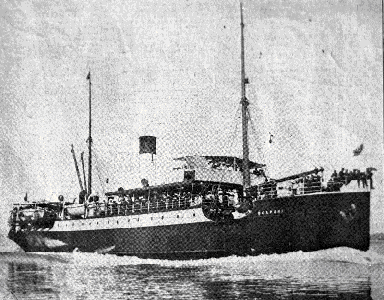 JT Diamond collection, Auckland Libraries, JTD-19M-04168 - photo taken in 1902
A twin screw steamer of 703 tons and 57.91 metres in length, she was built in Dundee, Scotland, and operated on the Onehunga - New Plymouth run by the Northern Steam Ship Company between 1900-03, and again from 1929-30, when "Rarawa" proved too large for the declining passenger numbers. She also served in a relieving capacity during this time.
Designed by George Gow, Northern's engineering superintendent, she arrived in Auckland on 12 October 1900 under the command of Captain W.F. Norbury. She could carry 130 passengers, and was powered by two Gourlay-designed engines which produced 160 horsepower, and a speed of 12 knots.
She suffered one mishap on the Manukau, running aground on soft mud on 17 November 1927, where she sat for nine hours before successfully refloating.
|
HMS Niger
|
The first Royal Navy vessel to grace the Manukau, she crossed the Bar on 29 November 1859, following a two-day voyage from Auckland. Under the command of Captain Peter Cracroft, the 1013 ton warship was, to this point, the largest to visit the Manukau, drawing up to eighteen feet. A corvette, she was built in Sunderland in 1848 by Sir James Laing and carried twelve 32-pound guns, one 68-pound gun (weighing 95 hundredweight!) and for work ashore, a twelve-pound brass field piece.
Her arrival was timely, as within four months, the year-long Maori wars broke out at Taranaki. Three months later, "Niger" lost 23 feet of its false keel when grounding at Onehunga, which sidelined her for two months while repairs were made in Sydney, for where she departed on 6 June 1860. She returned once repaired, one of at least eight calls into Onehunga before she departed for Portsmouth at 11am on May 9, 1861.
Other Royal Navy vessels to grace the Manukau include:
HMS Cordelia - an eleven gun steam sloop (see separate note above), which made at least seven calls under Captain Vernon;
HMS Fawn - a sixteen gun 748 ton steam sloop built in Deptford and launched on 30 September 1856, which made at least five calls under Captain Cator;
HMS Victoria - a 580 ton sloop built of mahogany and oak in Limehouse, London by Young and Magnay, she was launched in July 1855 and had seven 32-pound guns. She was loaned by the Victorian state government, making at least five calls under Captain W.H. Norman, including one from Wellington on 13 November 1860, arriving with HMS Niger;
HM Colonial Gunboat "Caroline" - part of the first NZ navy fleet, and served as the Manukau's guardship between April 1860 and November 1861 under Captain Hannibal Marks;
HMS Tasmanian Maid - an 85 ton paddle steamer built in South Stockton, Yorkshire, in 1856 which, like "Caroline", was engaged as a despatch boat during the Taranaki Maori Land Wars;
HMS Harrier - commanded by Sir Malcolm Gregor, she was a 748 gross tons sloop built in Pembroke and launched in 1854. With sixteen guns, she arrived in June 1861. From New Zealand, she went to Fiji in 1862 before returning to Portsmouth in April 1864. She was broken up there two years later;
HMS Miranda - a 1039 ton fifteen-gun corvette commanded by Captain Glynn, she was built in Sheerness in 1851 and arrived after an eight-day voyage from Sydney on 26 April 1861, succeeding "Niger" as the Royal Navy's principle presence on the Manukau;
HMS Eclipse - called in during the Waikato War to provide assistance at the Manukau Heads following the sabotage (cutting down) of the flagstaff on Paratutai after darkness fell on 7 November. Commander Mayne and Lieutenant Coddington's ship was charged with guarding Onehunga "until further notice". She was the first British man-of-war vessel to grace the Waikato River. Her brief grounding at the Manukau Harbour entrance on January 2, 1865, with 288 troops on board, was the catalyst for the withdrawal of Her Majesty's ships from using the Manukau two months later;
HMS Falcon - boasting seventeen guns, she succeeded HMS Harrier as a guardian of the port for eight months.
|
Oregon
|
A flat-bottomed ship, she provided Matthew Roe with transport for his business' product, timber, from a busy sawmill at Kauri Point. Buily by James McIntyre's Clyde Iron Works in Onehunga in 1865.
|
Oriental Queen
|
Under the command of Captain Theodore M. Houltain, she carried the last of the Fencibles in September 1849.
|
Osprey
|
A regular sight on the Manukau in 1842 and 1843, carrying timber to the likes of Australia, China and The Philippines.
|
HMS Pandora
|
This 319 ton brig, under the command of Captain Byron Drury, arrived on 5 February 1853 in order to carry out the most comprehensive survey of the Manukau Harbour yet held, a survey which was instrumental in the history of the harbour and the Port of Onehunga. An indiciation of how much work was involved came three days after her arrival, when she ran aground in the harbour.
|
Penguin
|
Built in Glasgow in 1864, she was acquired by the Union Company in 1879 to replace "Taupo", following the latter's demise in February of that year. "Penguin" spent considerable time on the Dunedin - Onehunga service between 1879 and 1882.
|
Phoebe
|
650 tons and 120hp, she operated a monthly service between Onehunga and Bluff, via New Plymouth, Nelson, Picton, Wellington, Lyttelton and Port Chalmers. The voyage was slated to commence on the 24th of each month, reaching Bluff on the 5th of the following month, and commencing the northbound voyage next day, to arrive at Onehunga on the 17th of the month.
|
Pioneer
|
Operated during the Waikato campaign, this flat-bottomed stern-wheeler boasted twelve pound guns and two eight-by-twelve cupolas pierced for rifles as part of her armament. Rigged as a three-masted fore-and-aft schooner, she was the first purpose-built river gunboat designed for New Zealand conditions, and set out from Sydney on 22 September 1863 under tow by HMS "Eclipse", reaching Onehunga on 3 October, before local engineer George Ellis secured quarter-inch iron plates to her bulwarks to protect her from bullets.
Measuring 140 x 20 x 2.5 feet, she was powered by two 30hp engines thriugh 12 x 7 feet paddles, and was designed to pull barges carrying up to 400 men. She was armed with two rotating Armstrong 12-pounders in cupolas 8 feet high, and would usually transport troops from Point Russell to Ngaruawahia, the Maori capital.
|
Prince Alfred
|
A 1200 ton steamer which sailed from Sydney to Onehunga via Nelson in the late 1850s as part of a monthly mail service inaugurated between Great Britain and Australia and New Zealand via the Isthmus of Suez, a service known in this area of the world as the Intercolonial Royal Mail Steam Packet Company. She first arrived on the Manukau from New Plymouth on 22 February 1859, three days after arriving in Nelson from Sydney, to whence she returned from the Manukau on February 26.
|
Ramillies
|
Carried the first Fencibles contingent - 260-strong, made up of 67 Fencibles plus families - to arrive, under Captain William Kenny's command, in August 1847.
|
Rapid
|
The first major warship to cross the Bar since "Orpheus", she did so in 1896 amidst much pomp and ceremony.
|
Rotoiti
|
Transported the first contingent to fight in the Boer War from Onehunga to Wellington on 9 October 1899.
Subsequently employed on the Onehunga - New Plymouth trade until mid-1909.
|
Rotorua
|
Built in 1876 by William Denny and Brothers in Dumbarton, she was the first Union Company ship to make a trans-tasman voyage, she did so from Dunedin via Lyttelton, Wellington, Nelson, New Plymouth and Onehunga to Sydney, setting off on 10 January 1877.
|
Rowena
|
The first Northern Steam Ship Company vessel to operate between Onehunga and New Plymouth. A 108 ton steamer, built by Henry Niccol at Auckland in 1872, she was 101.6 feet in length, and inaugurated Northern's northern run in 1881. She was broken up in Timaru in July 1905.
|
Tainui
|
A 128.42 ton wooden ship of 24 horsepower built by J. Logan at Auckland in 1903, she was a 72 ton steamer which linked Onehunga with Patea and Mokau. Owned by A.W. Ogle for the majority of her career, it was while sporting the colours of the NZ Refrigerating Company that she met her end on 16 September 1919, exploding while carrying a cargo of petrol.
|
Takapuna
|
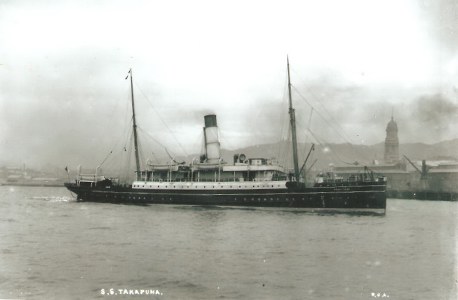 Internet-purchased photo
Built in 1883 in Barrow-in-Furness for Union Company to provide a fast mail and passenger service between Lyttelton and Onehunga via Wellington (a two-hour turnaround) and New Plymouth (one hour) in 36 hours at a service speed of 14 knots. Among her passengers on a southbound run from Onehunga in late 1895 was the famous American writer, Mark Twain!
Except for a period in 1889, when her services were required to provide extra passengers for an exhibition in Dunedin, she remained on the Lyttelton-Onehunga run until 1908, when the main trunk railway service commenced.
Her first voyage commenced on 19 November 1883. She carried under 300 tons of cargo and provided berths for 150 passengers in 35 cabins. She also boasted a large mailroom in the after 'tween deck area, which was used for sorting mail arriving at Auckland off the trans-Pacific steamers.
Another unusual feature was the elevated spotlight on her forecastle, which was installed specifically for use when negotiating the Manukau at night - to meet the turnaround time, she arrived and sailed at all hours!
She was laid up in Wellington in 1917, and was eventually scuttled in Cook Strait on 18 June 1925.
|
Tam O'Shanter
|
Built in Newmarket in 1874, her kauri planking was cut in Papakura, while her ironwork was produced by McIntyre's Clyde Ironworks of Onehunga, and her high pressure engines sourced from the local Fraser & Tinne foundry. She was carried via the newly opened Onehunga railway to Onehunga, where she was launched, averaging eight knots on her sea trials. Her maiden voyage to Waiuku took four hours.
|
Taranaki
|
A 443 gross ton iron steamer built in Glasgow in 1865 which operated for the NZ Steam Shipping Co Ltd between 1871 and 1875 linking Onehunga with New Plymouth, Nelson, Picton, Wellington, Lyttelton and Dunedin, transhipping passengers and cargo at Wellington for Napier, Poverty Bay and Wanganui, and at Nelson for Westport, Greymouth and Hokitika.
She initially commenced a Manukau to Bluff monthly Government mail service in June 1866 for the NZ Steam Navigation Company, departing her various ports at circa noon. The service only lasted six months. And in August 1868, she struck a rock and sank in Tory Channel, only to be salvaged a year later and put back into service by late October 1869.
|
Taupo
|
With "Hawea", a real 'pioneer' of North Island coastal trade, which from July 1875 carried out a twelve-day round trip between Onehunga, New Plymouth, Nelson, Picton, Wellington, Lyttelton and Dunedin, carrying mail, cargo and passengers, regularly keeping to schedule despite her lack of horsepower (800hp).
Both ships were built by William Denny and Brothers in Dumbarton, and were operated by the Union Steam Ship Company. They boasted a crew of 22, and were of 721 gross tons apiece.
In 1878, her run was extended to cover the North Island's east coast until, in February 1879, she was wrecked off the Tauranga Harbour. She was later raised, but the same fate befell her again in April 1881 off Mayor Island.
|
Tranmere
|
One of the first timber trading vessels, she arrived on the Harbour in 1831 with Captain Smith and Waikato chief Te Wherowhero aboard.
|
Victory
|
Captains James Cummins and William Currie purchased this Kawhia-built schooner in 1847 for trading between Onehunga, Kawhia and Raglan. She carried timber to the Waikato Heads.
|
Waipa
|
Built in 1864 by David Hutchinson, Onehunga, she was sold to the Waikato Steam Navigation & Coal Mining Co Ltd of Ngaruawahia six years later, and broken up in 1881.
|
Waiuku
|
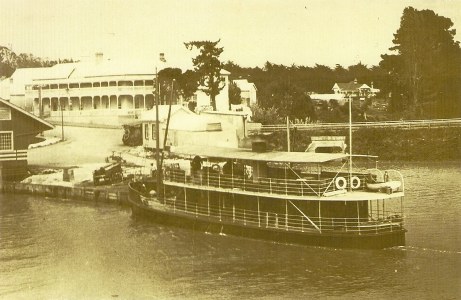 An unusual ship, in that she was designed by Thornycrofts and built in Basingstoke in 1912-13 as a pre-fabricated hull for Northern Steam Ship Company, and was brought to New Zealand in sections before being assembled by Massey Bros at Onehunga in 1913 for use on the Onehunga - Waiuku passenger service for a number of years.
She was launched on 3 September 1913 and was powered by weight-saving kerosene engines, allowing her to complete the Onehunga-Waiuku run in 2.5 hours, including all stops en route.
|
Wanaka
|
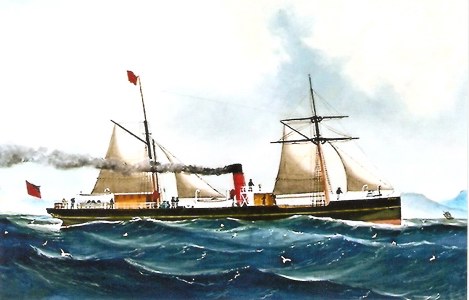 Built in 1876 in Whiteinch, she was the first Union Company steamer to go alongside the New Plymouth breakwater on 22 March 1884, a feat witnessed by around 500 locals. Weighing some 493 tons, she was on passage from Onehunga to New Plymouth when she was wrecked on Puketapu Reef, near Waitara, on 2 April 1891.
|
Weka
|
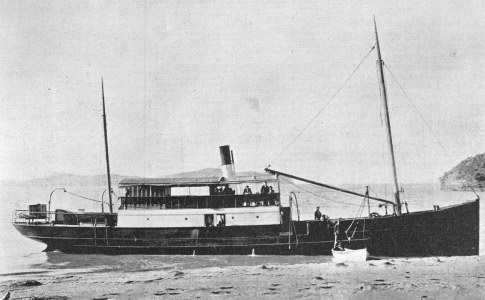 Photo of Weka from the Sir George Grey Special Collection, 7-A15681
Built by William Holmes in 1894 for the Waiuku Steam & Navigation Company, she replaced "Manukau" on the Waiuku-Onehunga run, and furthered the service with stops at Graham's Beach, Awhitu, Waiau Pa, Pollok, Te Toro and Waipipi from 1894 to 1913, with the Manukau Steamship Company and the Northern Steam Ship Company also owning her during this time. Cargoes loaded at Onehunga were mainly manufactured goods, while those landed included cattle and other agricultural goods. She was eventually broken up at Auckland in 1940.
Endured two fires on board at Onehunga, and another in 1906.
|
Wellington
|
A 429 gross ton ship built in Glasgow in 1863 which operated for the NZ Steam Shipping Co Ltd between 1871 and 1875 linking Onehunga with Taranaki, Nelson, Picton, Wellington, Lyttelton and Dunedin, transhipping passengers and cargo at Wellington for Napier, Poverty Bay and Wanganui, and at Nelson for Westport, Greymouth and Hokitika.
|
White Swan
|
Replaced "Zingari" on the Manukau to Otago run. She arrived on the Manukau on June 22, 1858, sailing six days later following the signing of a service contract which took her through to April 1859. She was then replaced by a combination of "Airedale", "Lord Ashley", "Lord Worsley" and "Prince Alfred" as the Intercolonial Royal Mail Steam Packet Company established itself in early New Zealand life.
|
Wild Wave
|
A schooner of 39.21 tons and 59 feet in length, she was launched in 1861 by James Alexander. She was damaged in Constant Bay on 16 September 1878 under the command of Captain John Grubb, and foundered without trace with all hands between Lyttelton and Pelorus Sound on 12 October 1883, owner Captain C. Smith among those lost.
|
Woodpecker
|
A river barge 0f 28.83 tons and 58.5 feet in length built at Onehunga in 1865 and altered to a paddle steamer a year later by owner E. Gibbons. She was sold to Nelson interests in 1867, and was wrecked at Patea on 28 February 1869 while operating for Taylor and Watt of Wanganui.
|
Zingari
|
A 148 ton, 430 horsepower vessel built in 1852 in Radcliffe, Cross Dock, Middlesex which provided a fortnightly service under the command of Captain Milton between Dunedin and Onehunga from July 1855 through till May 1857, succeeding "Nelson" on the run. She was built as a pleasure yacht, and arrived in NZ under Captain Milltown. Oscillating cylinders were a feature of her engines.
Calls to the Manukau in 1855 materialised on 3-9 July, 7-11 August, 12-18 September and on 15-19 October. On this voyage, her manifest included the entire contents of Foley's Circus - including all the animals! It was also on this voyage that she grounded slightly when crossing the Bar. On another visit, on 5 December that year, no pilot was awaiting her arrival, prompting Captain Milton to write a letter of complaint which was to come to light again after events on 10 May 1857, when "Zingari" grounded in a squall soon after entering the Manukau, remaining stuck fast until the next tide.
|
Information sourced from:
was utilised in this compilation